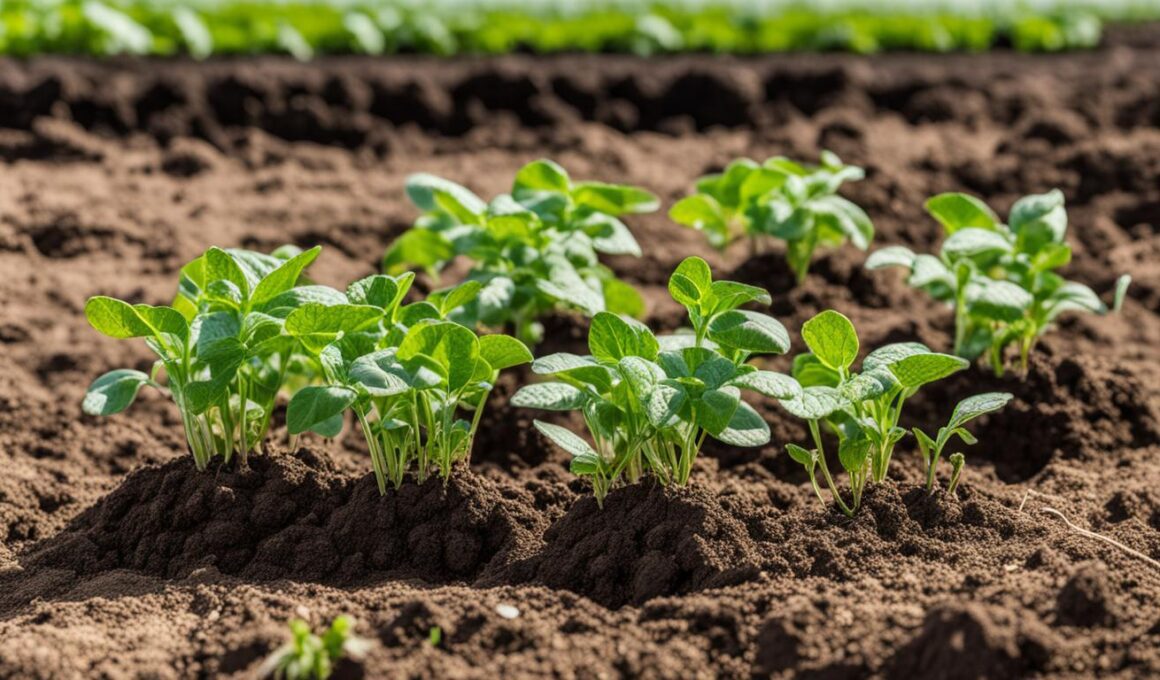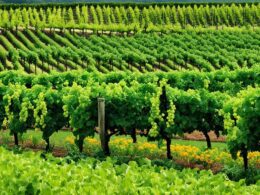Have you ever wondered what potato plants look like? It can be challenging to identify them, but with the right knowledge, it becomes easier. Let’s take a closer look at the appearance and features of potato plants.
Above the ground, potato plants have sturdy, upright stems with a distinct zig-zag pattern. The leaves are vibrant green and compound, consisting of multiple smaller leaflets. These leaflets are oval-shaped with pointed tips and have a slightly crinkly appearance.
But that’s not all. Potato plants also produce stunning flowers in various colors such as white, pink, purple, or blue, depending on the variety. These flowers have a star-shaped structure with five petals and bright yellow centers.
Underground, the real magic happens. That’s where the potatoes develop. As the tubers form, you may notice signs such as the ground cracking or mounding up slightly around the base of the plant.
Now that you know what potato plants look like, you can confidently identify them in your garden or while exploring nature. Stay tuned for more information on potato plant growth stages and tips for successful cultivation.
The Growth Stages of Potato Plants
Potato plants undergo several stages of growth, each crucial for the development of the plant and the formation of its edible tubers. Understanding these stages will enable you to successfully cultivate and harvest a bountiful potato crop.
1. Selecting Seed Potatoes: Begin by choosing disease-free potatoes specifically meant for planting. These seed potatoes ensure healthier plants and higher yields.
2. Planting Potatoes: Plant the seed potatoes in the cool season, ensuring protection from hard frosts. Create furrows or mounds in prepared soil and space the seed potatoes at a predetermined distance to allow for proper growth.
3. Sprouts and Vegetative Growth: After planting, the seed potatoes develop sprouts from their eyes. These sprouts grow into leafy green vegetation, which is known as vegetative growth. During this stage, the potato plant focuses on building a strong root system and abundant foliage.
4. Tuber Formation: As the vegetative growth progresses, tubers begin to form underground. The potato plant allocates energy and nutrients to develop these tubers, which will eventually become the edible potatoes we enjoy.
5. Tuber Growth: With the establishment of tubers, the potato plant continues to grow and expand. The tubers increase in size, allowing them to store essential nutrients and moisture for maturation and future sprouting. Keep the plants well-watered and provide proper nutrition during this stage.
6. Flowering: Approximately 60 to 70 days after planting, potato plants produce flowers. The flowers can be white, pink, purple, or blue, depending on the variety. While the flowers add beauty to the plant, they are also an indicator that the tubers are continuing to grow.
7. Maturation and Harvest: Following the flowering stage, the potato plant begins to mature. As the top vegetation starts to yellow and die back, the tubers reach their optimal size and quality. At this point, it’s time to harvest the potatoes, usually around 120 days after planting. Harvest the potatoes carefully to avoid damaging them, and store them in a cool, dark, and well-ventilated place until you’re ready to enjoy them.
How Can I Protect My Asparagus Plants from Deer?
If you’re dealing with deer eating habits ruining your asparagus plants, there are a few things you can do to protect them. Consider installing a fence around the plants or using deer repellent sprays. Another option is to plant deer-resistant flowers and herbs nearby to deter the deer.
Tips for Growing Potato Plants
Growing potato plants successfully requires providing them with optimal growing conditions. These plants thrive in full sun, so make sure they receive at least 6 hours of direct sunlight per day. The ideal temperature range for potato plants is between 65°F and 80°F during the day and 55°F to 65°F at night.
When it comes to the soil, potato plants prefer well-drained and slightly acidic conditions, with a pH level between 5.0 and 6.0. Ensure the soil has good drainage to prevent root rot and diseases. After planting, it is essential to fertilize the plants to provide them with the necessary nutrients for healthy growth. Mulching around the base of the plants can also help control weeds and maintain soil moisture.
When planting potatoes, be sure to choose seed potatoes that are firm, healthy, and disease-free. Larger potatoes can be cut into sections, with each section containing at least one “eye” or sprout. Allow these cut sections to dry for a few days before planting them in the ground. This process helps to prevent the development of fungal diseases.
Throughout the growth stages of potato plants, it is crucial to monitor for common pests and diseases. The Colorado Potato Beetle is a common pest that can damage the foliage and tubers of potato plants. Regular inspection and prompt removal can help control their population. Another common issue is potato leafhoppers, which can cause stunted growth and yellowing of the leaves. Applying appropriate insecticides and implementing proper cultural practices can prevent or mitigate these problems. Additionally, regularly remove weeds that may compete with potato plants for nutrients and water.
By following these tips and providing the optimal growing conditions, you can ensure the healthy and successful growth of your potato plants, leading to a bountiful harvest of delicious potatoes.









